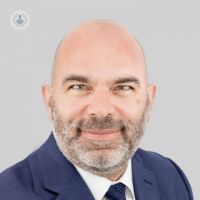What are childbirth perineal trauma and injury?
Written in association with:Although childbirth has become much safer than it once was thanks to medical advancements, childbirth perineal trauma and injury are something that women should be made aware of. In our latest article, renowned consultant obstetrician, gynaecologist, and urogynaecologist, Professor Stergios Doumouchtsis shares how a mother can be affected during childbirth. The London-based consultant outlines some causes, risk factors, and treatments available.

How can childbirth trauma and/or injury affect the mother?
Childbirth perineal trauma affects millions of women worldwide. It. It is very common, with an incidence of over 91% in women who give birth for first time, and over 70% in those who have experienced childbirth before. It can have a potentially significant impact on women's lives and affect their daily activities, psychological and psychosexual well-being, and overall quality of life.
What are the most typical injuries resulting from childbirth that you have experienced?
The most common injuries that are related to childbirth, especially vaginal childbirth, involve trauma to the vulva, vaginal and perineal skin, the muscles underneath the perineal muscles. These traumas can be associated with an increased risk of bleeding during childbirth. Additionally, in fewer cases, there may be an injury to the labia, clitoris, paraurethral tissues, and in some cases the anal sphincter.
What causes these injuries or this trauma to occur?
There are several risk factors related to the mother, baby, process of labour, or delivery that can affect the incidence of these injuries occurring at the time of childbirth.
A large size baby, a disproportion between the maternal anatomy and the position or the size of the baby, and other health factors, such as diabetes, resulting in large babies may also play a role. The pace of labour, either very prolonged or very quick labours, and the use of instruments, such as forceps, can also increase the risk of perineal trauma.
What treatment is offered to women who suffer from childbirth injury or trauma?
During pregnancy, women should be informed about the process of labour, the risks of trauma, possible prevention of trauma, and the treatment options available if necessary. For example, very superficial trauma, which is called the first-degree tear and involves only the skin of the perineum, the vagina, or the labia, often does not need suturing and will heal spontaneously during the postnatal period. Cases of trauma that involve muscles would require suturing at the time of childbirth.
Healing complications may result in chronic pain, difficulties with sexual intercourse, issues with self-image, and if the anal sphincter is affected, fecal incontinence may result. There are treatments available. Pelvic floor exercises, both before and after childbirth, help improve the quality of the muscles, preparing the pelvic floor for birth and rehabilitating the muscles following childbirth.
How can it be successfully and effectively prevented?
The natural progress of pregnancy, labour, and delivery can often be unpredictable, making the prevention of childbirth trauma difficult.
- From the mother's point of view, maintaining a healthy lifestyle, healthy diet and weight during pregnancy, and following the advice of the specialists, can reduce the risk.
- Regular visits to the antenatal clinics and reviews by the midwife or the obstetrician as required will identify any risk factors and, in many cases, help mitigate these risks.
- Pelvic floor exercises before childbirth help strengthen pelvic floor muscles, improve control during the time of labour and birth, and reduce the risk for perineal trauma.
- Good hygiene after birth is also important.
- Continuing with the pelvic floor exercises postnatally will help rehabilitate the pelvic floor muscles.
According to the degree and the extent of the trauma, different advice is usually offered to women about the healing process to ensure healthy healing of the tissues. In some cases, additional interventions are possibly required if there are healing complications postnatally.
If you would like to book a consultation with Professor Stergios Doumouchtsis, you can do so by visiting his Top Doctors profile.


